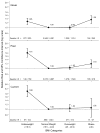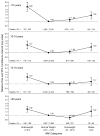Association of body mass index and weight change with all-cause mortality in the elderly
- PMID: 16641311
- PMCID: PMC3373260
- DOI: 10.1093/aje/kwj114
Association of body mass index and weight change with all-cause mortality in the elderly
Abstract
The authors explored the relation of body mass index (BMI; weight (kg)/height (m)(2)) and weight change to all-cause mortality in the elderly, using data from a large, population-based California cohort study, the Leisure World Cohort Study. They estimated relative risks of mortality associated with self-reported BMI at study entry, BMI at age 21 years, and weight change between age 21 and study entry. Participants were categorized as underweight (BMI <18.5), normal weight (BMI 18.5-24.9), overweight (BMI 25-29.9), or obese (BMI >or=30). Of 13,451 participants aged 73 years (on average) at study entry (1981-1985), 11,203 died during 23 years of follow-up (1981-2004). Relative to normal weight, being underweight (relative risk (RR) = 1.51, 95% confidence interval (CI): 1.38, 1.65) or obese (RR = 1.25, 95% CI: 1.13, 1.38) at study entry was associated with increased mortality. People who were either overweight or obese at age 21 also had increased mortality (RR = 1.17, 95% CI: 1.09, 1.25). Participants who lost weight between age 21 and study entry had increased mortality regardless of their BMI category at age 21. Obesity was significantly associated with increased mortality only among persons under age 75 years and among never or past smokers. This study highlights the influence on older-age mortality risk of being overweight or obese in young adulthood and underweight or obese in later life.
Conflict of interest statement
Conflict of interest: none declared.
Figures


References
-
- Heiat A, Vaccarino V, Krumholz HM. An evidence-based assessment of federal guidelines for overweight and obesity as they apply to elderly persons. Arch Intern Med. 2001;161:1194–203. - PubMed
-
- Flegal KM, Graubard BI, Williamson DF, et al. Excess deaths associated with underweight, overweight, and obesity. JAMA. 2005;293:1861–7. - PubMed
-
- Paganini-Hill A, Hsu G, Chao A, et al. Comparison of early and late respondents to a postal health survey questionnaire. Epidemiology. 1993;4:375–9. - PubMed
-
- National Heart, Lung, and Blood Institute. Clinical guidelines on the identification, evaluation, and treatment of overweight and obesity in adults: the evidence report. Bethesda, MD: National Heart, Lung, and Blood Institute; 1998. [Accessed October 20, 2005]. ( http://www.nhlbi.nih.gov/guidelines/obesity/ob_gdlns.pdf)
-
- Katzmarzyk PT, Janssen I, Ardern CI. Physical inactivity, excess adiposity and premature mortality. Obes Rev. 2003;4:257–90. - PubMed

